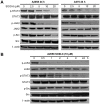Spirooxindole derivative SOID-8 induces apoptosis associated with inhibition of JAK2/STAT3 signaling in melanoma cells
- PMID: 23166634
- PMCID: PMC3500295
- DOI: 10.1371/journal.pone.0049306
Spirooxindole derivative SOID-8 induces apoptosis associated with inhibition of JAK2/STAT3 signaling in melanoma cells
Abstract
Melanoma is generally refractory to current chemotherapy, thus new treatment strategies are needed. In this study, we synthesized a series of spirooxindole derivatives (SOID-1 to SOID-12) and evaluated their antitumor effects on melanoma. Among the 12 spirooxindole derivatives, SOID-8 showed the strongest antitumor activity by viability screening. SOID-8 inhibited viability of A2058, A375, SK-MEL-5 and SK-MEL-28 human melanoma cells in a dose- and time-dependent manner. SOID-8 also induced apoptosis of these tumor cells, which was confirmed by positive Annexin V staining and an increase of poly(ADP-ribose) polymerase cleavage. The antiapoptotic protein Mcl-1, a member of the Bcl-2 family, was downregulated and correlated with SOID-8 induced apoptosis. In addition, SOID-8 reduced tyrosine phosphorylation of Signal Tansducer and Activator of Transcription 3 (STAT3) in both dose- and time-dependent manners. This inhibition was associated with decreased levels of phosphorylation of Janus-activated kinase-2 (JAK2), an upstream kinase that mediates STAT3 phosphorylation at Tyr705. Accordingly, SOID-8 inhibited IL-6-induced activation of STAT3 and JAK2 in melanoma cells. Finally, SOID-8 suppressed melanoma tumor growth in a mouse xenograft model, accompanied with a decrease of phosphorylation of JAK2 and STAT3. Our results indicate that the antitumor activity of SOID-8 is at least partially due to inhibition of JAK2/STAT3 signaling in melanoma cells. These findings suggest that the spirooxindole derivative SOID-8 is a promising lead compound for further development of new preventive and therapeutic agents for melanoma.
Conflict of interest statement
Figures






Similar articles
-
Thymoquinone induces oxidative stress-mediated apoptosis through downregulation of Jak2/STAT3 signaling pathway in human melanoma cells.Food Chem Toxicol. 2021 Nov;157:112604. doi: 10.1016/j.fct.2021.112604. Epub 2021 Oct 7. Food Chem Toxicol. 2021. PMID: 34627931
-
A novel 7-bromoindirubin with potent anticancer activity suppresses survival of human melanoma cells associated with inhibition of STAT3 and Akt signaling.Cancer Biol Ther. 2012 Nov;13(13):1255-61. doi: 10.4161/cbt.21781. Epub 2012 Aug 16. Cancer Biol Ther. 2012. PMID: 22895078 Free PMC article.
-
Sorafenib inhibits endogenous and IL-6/S1P induced JAK2-STAT3 signaling in human neuroblastoma, associated with growth suppression and apoptosis.Cancer Biol Ther. 2012 May;13(7):534-41. doi: 10.4161/cbt.19603. Epub 2012 May 1. Cancer Biol Ther. 2012. PMID: 22406995
-
The JAK2/STAT3 pathway is involved in the anti-melanoma effects of brevilin A.Life Sci. 2020 Jan 15;241:117169. doi: 10.1016/j.lfs.2019.117169. Epub 2019 Dec 14. Life Sci. 2020. PMID: 31843524
-
Spirooxindole: A Versatile Biologically Active Heterocyclic Scaffold.Molecules. 2023 Jan 7;28(2):618. doi: 10.3390/molecules28020618. Molecules. 2023. PMID: 36677676 Free PMC article. Review.
Cited by
-
Signal transducer and activator of transcription-3 drives the high-fat diet-associated prostate cancer growth.Cell Death Dis. 2019 Sep 2;10(9):637. doi: 10.1038/s41419-019-1842-4. Cell Death Dis. 2019. PMID: 31474764 Free PMC article.
-
Naturally derived indole alkaloids targeting regulated cell death (RCD) for cancer therapy: from molecular mechanisms to potential therapeutic targets.J Hematol Oncol. 2022 Sep 14;15(1):133. doi: 10.1186/s13045-022-01350-z. J Hematol Oncol. 2022. PMID: 36104717 Free PMC article. Review.
-
MLS-2384, a new 6-bromoindirubin derivative with dual JAK/Src kinase inhibitory activity, suppresses growth of diverse cancer cells.Cancer Biol Ther. 2014 Feb;15(2):178-84. doi: 10.4161/cbt.26721. Epub 2013 Nov 1. Cancer Biol Ther. 2014. PMID: 24100507 Free PMC article.
-
Targeting STAT3 in Cancer Immunotherapy.Mol Cancer. 2020 Sep 24;19(1):145. doi: 10.1186/s12943-020-01258-7. Mol Cancer. 2020. PMID: 32972405 Free PMC article. Review.
-
Context-dependent miR-204 and miR-211 affect the biological properties of amelanotic and melanotic melanoma cells.Oncotarget. 2017 Apr 11;8(15):25395-25417. doi: 10.18632/oncotarget.15915. Oncotarget. 2017. PMID: 28445987 Free PMC article.
References
-
- Gray-Schopfer V, Wellbrock C, Marais R (2007) Melanoma biology and new targeted therapy. Nature 445: 851–857. - PubMed
-
- Chin L, Garraway LA, Fisher DE (2006) Malignant melanoma: genetics and therapeutics in the genomic era. Genes Dev 20: 2149–2182. - PubMed
-
- Eggermont AM, Robert C (2011) New drugs in melanoma: it's a whole new world. Eur J Cancer 47: 2150–2157. - PubMed
Publication types
MeSH terms
Substances
Grants and funding
LinkOut - more resources
Full Text Sources
Medical
Molecular Biology Databases
Miscellaneous

